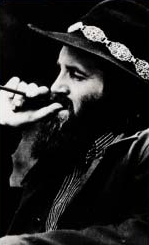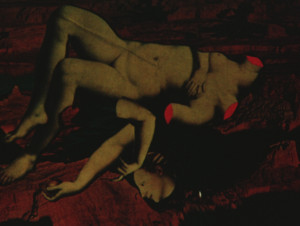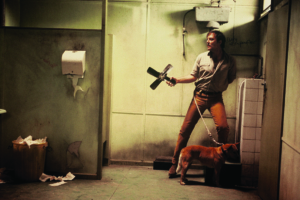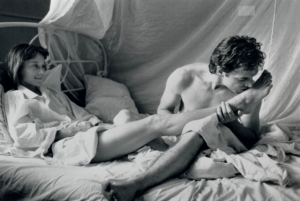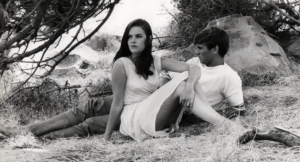Throughout his prolific career, Albie Thoms has directed theatre, made a number of independent experimental films, worked in television and feature film production, and written on aspects of independent film in Australia.
As a founding member of the Ubu film co-operative in Sydney in the mid-1960s (the other founders were David Perry, Aggy Read and John Clark), Thoms directed a number of innovative and progressive films, including, among others, … it droppeth as the gentle rain (co-directed with Bruce Beresford, 1963), Man and His World (1966), Rita and Dundi (1966), Bluto (1967), Moon Virility (1967), Bolero (1967), and Marinetti (1969), a feature-length work which records, in a style that utilises a range of optical effects, an encounter at a party between a man and his present and former female companions.
During the late 1960s Thoms also freelanced as a director for ABC television. His work from this period includes episodes of Contrabandits, Skippy the Bush Kangaroo and Australian Playhouse, among other series.
For a decade from the mid-1960s he wrote film criticism for various alternative local and international magazines, including Tracks, Planet, The Living Daylights, Oz, International Times and Friends. Many of these pieces, together with those published elsewhere, were collected in his Polemics for a New Cinema (Wild and Woolley, Sydney, 1978).
In 1973 he made the experimental feature film Sunshine City, a kaleidoscopic personal essay on Sydney, and in 1979 he completed Palm Beach, a feature-length multi-layered narrative dealing with alternative lifestyles on Sydney’s northern beaches. The use of diegetic and non-diegetic sound in Palm Beach reflects, in part, his interest in pop and rock music. In the early 1970s he made J.O.K: The Wild One for Australian commercial television and Rock Around the World for SBS. In the late 1980s he directed a number of corporate and independent videos and completed several film scripts. His films and videos screened in numerous Australian and international festivals throughout the 1990s.
Thoms has long been involved with the surf film. In 1972 he edited the classic surf film Morning of the Earth, and in the early 1980s he made the documentary film Surfmovies, for West German television, and a documentary dealing with Australian beach culture, From Neck-to-Knee to Nude, for Australian television. His interest in filmic representations of surfing is extended in the recent publication of his book, surfmovies (Shorething Publishing, Noosa, 2000), an analysis of the genre from its beginnings to the present.
Albie Thoms lives and works in Sydney. The following interview took place in 2000 in Noosa during the town’s annual longboard surfing festival, at which Thoms presented a programme of surf film and video.
Keith Beattie: Phillip Adams has singled out your … it droppeth as the gentle rain as a film of the 1960s that contains a ‘certain raw, antipodean energy’.[1]Phillip Adams, ‘A Cultural Revolution’, in Scott Murray (ed.), Australian Cinema, Allen and Unwin, Sydney, 1996, p.61. Did you intend to forge a distinctly Australian avant-garde aesthetic with the film?
ALBIE THOMS: No. The film had a scenario by Jaques Prevert that I recognized was completely relevant at the time because it contained a metaphor of world destruction. It was the time of the Cuban missile crisis and the world was being threatened with atomic fallout, so in my film I use images of shit falling from the sky as an appropriately absurd reaction to the historical context. I thought I was very much a part of the European modernist tradition in doing that, and I incorporated the film into my stage show, A Revue of the Absurd.[2]Peter Mudie describes A Revue of the Absurd in Ubu Films: Sydney Underground Movies, University of NSW Press, Sydney, 1997, p.18 and 27. I was taking on a bit of an educative role, I guess, in trying to make people aware of modernism. This was in the very early 1960s in Australia when theatre and the almost non-existent cinema were extremely conservative and anti-modernist. The film was banned and that action made me aware that the ideas it contained were more radical than I had thought. The fact that it was banned made me consciously seek to use radical ideas to try to bring about changes in society. It alerted me to the need to create an avant-garde to smash down reactionary ideas in society and in film-making.
Traditions of absurd drama have not been widely exploited in Australia. How did you gather the sources for your film and revue?
I scoured libraries for things that were published on the topic in the ’30s and ’40s. I’d correspond with people whose names I located in little magazines and they would give me material and ideas and it was through such contacts that I corresponded with European and American underground film-makers. Many of those people were poets and playwrights as well as film-makers and in many cases film wasn’t their primary art form – it was another medium of expression that they were using, and one that had been denied to many people for a long while. There was a certain excitement in having access to the medium, which had been entrenched in the Hollywood system. The inspiration, then, for my early films came from the European theatrical avant-garde and ideas derived from the cinematic avant-garde which had experimented with the film medium in the 1920s.
In 1967 Michael Snow made Wavelength, a 45-minute zoom through a New York loft to an image of waves tacked on a wall. In the same year you made Bolero, a 14-minute tracking shot along a North Sydney street to the eye of a seated woman. Like Wavelength, the tracking shot in Bolero is the form and the content of the film. Yet, unlike Wavelength, Bolero marries this practice with music, thereby underscoring the place of sound as a central component of form – a technique explored in another manner in Palm Beach, where diegetic and extra-diegetic sound perform the narrative function of linking one scene to another. Who inspired you to explore ‘sonic cinema’?
It goes back to Artaud’s theory of theatre. He saw sound as an equal component to any concrete elements. He was interested in the sonic impression created in the theatre by words and by music, which he wanted the audience to experience. His approach was opposed to the use of music as a direct signifier of a particular meaning. In a sense, the idea for Bolero came directly from the music – just listening to the music and seeing the shot.
I must say it’s fascinating that my idea for the tracking shot in Bolero came about at the same time as Michael Snow’s use of the zoom shot in Wavelength. The correspondence was the result of common influences, rather than direct communication between us. The influences derive in part from what became known as the hippie psychedelic culture and, once again, it goes back to the little magazines and the interplay of alternative ideas available within their pages. I think at that time Sydney was ahead of many places in the world for such ideas. It was San Francisco, Sydney, then maybe London, and the three places communicated via underground magazines and people travelling
between those centres.
Were audiences at the time responsive to your work? For example, how did they react to Marinetti?
Marinetti proved extremely difficult for people because it was a feature film without a linear story and conventional forms of characterisation. Audiences found the plot bewildering and difficult to digest. My position was: forget about how you used to watch movies – think differently, absorb it differently, read it differently. I was trying to get audiences to experience the film as a stream of consciousness. By the time I made the film [1969] I thought that stream of consciousness was an accepted literary technique. I was a bit surprised that people couldn’t make the transference and accept it as a legitimate film technique.
Palm Beach is another of your films that reworks conventional approaches to film narrative. The film maintains an underground aesthetic in its various technical innovations and through the fact that it constructs a narrative at the same time that it deconstructs that narrative. Are you happy with that assessment?
Yes, I think that sums it up. I was always experimenting – constructing and deconstructing as simultaneous and interactive forces, which is a strong element of Marinetti’s ideas and the futurist theory that I applied in the film. With Palm Beach I developed strong narrative lines and characters that could be seen performing various tasks and activities which were filmed and constructed in a way that questioned the action. Palm Beach constructs three linear narratives simultaneously, while at the same time deconstructing the whole idea of linearity.
Palm Beach was shown on commercial television on the Seven network. The station screened it as a regular film without making any concessions and it didn’t rate particularly highly but it wasn’t a non-rater and it didn’t, as far as I know, have people ringing up and complaining. It demonstrated to me that in the period since Marinetti, and perhaps because of such work, audiences have become aware of a variety of narrative techniques and are capable of doing more interpretative work than that usually required of them by the routine fare screened on television.
Palm Beach has a documentary quality. The characters are studied closely in ways reminiscent of cinema verité, a reference which is further suggested in the handheld camera work. Did you consider cinema verité, or the documentary mode in general, as an influence on your film-making?
Absolutely. I hinted in my book [surfmovies] that cinema verité was a development which, to a large extent, was initially denied to Australians. Many cinema verité films were made for television in America but never shown on television in Australia. Others were theatrical films dealing with pop music that didn’t get screened in Australia until many years after they were made. So, the major influential works of cinema verité weren’t being seen in Australia. I read film journals that included accounts of cinema verité and I did see occasional films at film festivals. There wasn’t any documentary movement in Australia during the 1960s that might have been influenced by cinema verité. The full impact of the mode didn’t emerge in Australia until the ’80s.
I was always fascinated by the theory of cinema verité. The use of handheld cameras appealed to me, as did filming subjects in long takes. The majority of the cinema verité films I’d seen used montage as the main form of construction, but whenever the action went in a direction that wasn’t of interest to the film-maker, the film would be edited to include cutaways. In Palm Beach I was interested in trying to maintain a whole scene in a single take. It was the challenge I set myself in Bolero. Although Hitchcock’s Rope (1948) was the obvious precedent for this approach, I was influenced to a great extent by cinema verité techniques. Instead of using the cut to advance or truncate the time of a scene, I used the cut to end a scene on the visual level and used the soundtrack to produce another scene which would create a parallel time.
The fate of Paul Kite (Bryan Brown) in Palm Beach offers a pessimistic view of life in Sydney, a view reinforced by the fact that the characters cannot connect, suggesting a world in disarray. This pessimism can be contrasted to the impression of Sydney you presented in Sunshine City (1973), which is a celebration of the city and its lifestyles. What factors accounted for the change in approach?
I think the time it took me to obtain the finance to make Palm Beach influenced my way of making it.[3]Susan Dermody and Elizabeth Jacka outline the lengthy process of securing funding for Palm Beach in an appendix to their book, The Screening of Australia: Anatomy of a Film Industry, vol.1, Currency Press, Sydney, 1987. I wrote a scenario for Palm Beach that I submitted for funding and it was rejected. I continued to submit the scenario to various funding bodies for the next four or five years. I was constantly told the idea wasn’t going to work. That response built up in my consciousness and invested the final film with a lot of pessimism. In many respects, Palm Beach was a 1974 film being made in 1979, a fact which was bound to have an effect.
If you were making the film today, knowing what you do about film funding bodies, what would you do differently?
I guess I wouldn’t make the film. Part of the reason it took so long to raise the funding for Palm Beach was that I proposed a radical way of making the film which wasn’t acceptable to the funding bodies. It was only through perseverance that I got the project through. Having persevered for a long time I was able to complete the film. I then applied for funding for another feature film and persisted for ten years with that proposal, got nowhere, and gave up.[4]The failed project was entitled The Big Smoke, the story of one person’s life in a city over a six month period. The film was to be shot only at night. Basically, I’ve learnt not to bother applying for funds for radical film, knowing no one is going to fund me. It certainly is extremely frustrating trying to raise money for a film, and even more frustrating having made the film to fail to be encouraged to go ahead and do another.
In the nexus of government funding of film-making and experimental film resided the Experimental Film and Television Fund (established in July 1970). It could be argued that government subsidy for experimental film dissipated the adversarial stance of many experimental/underground films. Is this a valid argument?
In a sense it did more than dissipate the initiative – it closed it right down. One way it did that was by gradually eliminating film-makers from experimental practice. One person that I found very inspiring in the ’60s when I was working with him was Garry Shead. He worked as a painter and cartoonist, and as a film-maker. His applications for film funding were repeatedly rejected; he was getting more encouragement as a painter, so his art narrowed into that medium. There are many other examples of creative people who had something to offer but were discouraged by the funding system and the result was a docile sort of film-making – less adventurous and less challenging to the society we live in. And so the Fund ceased to be called the Experimental Film Fund and its purpose changed. The underground impetus was lost when it became dependent on the funding process. Independent film-making in Australia lost its edge, lost its critical value.
During an interview on ABC television you noted the close productive relationship between Australian experimental film of the 1960s and rock music, which was going psychedelic at the time.[5]The interview was conducted for The Director’s Chair, 3 April 1981. This symbiosis of experimental film and rock music has, to a degree, been subsumed within the rock film clip, which commercialises both forms. Has the rock film clip been a development or a set back for experimental film?
For me it’s still the most experimental work available. Attending screenings of short films I occasionally see one that is somewhat experimental. Watching rock television it is possible to see more experiments with the medium than elsewhere in the industry. The symbiosis between rock videos and experimental works continues, even though the former has been commercialised to a large extent. There’s a similarity here with the development of surf movies and surf videos which, though heavily financed by surfing companies, are able to explore the medium in ways that the rest of the film industry, locked into narrative drama, is not capable of doing.
Your involvement with Morning of the Earth (1972), the surfing magazine Tracks, and your writings on surf film collected in Polemics for a New Cinema, all point to the surf movie as an influence on your work. Can you outline specific ways in which surf movies impacted on your work?
When I started making films the only really independent film activity other than underground film-making was surf movies. Surf films were an inspiration to film-makers in that they demonstrated that people in Australia could make films and show them to an audience and get sufficient money to make another film. That fact alone was astounding because the Australian film industry at that time was pretty well dead, no one would put any money into it.
The production and exhibition of surf films provided an alternative model to the Hollywood system. The way we made underground movies was similar to the practices involved in making and screening surf films. We shot films on weekends. We made a lot of short films and put them into a programme and then hired a theatre for screenings – in fact, we often deliberately hired the same theatres that the surf movie-makers used because we knew that surf films had established a niche market for alternative films.
Within that working economy one of the films that made a big impact on me was Paul Witzig’s first film, A Life in the Sun (1966), which was later released as The Hot Generation (1967). Paul was only about 24 or 25 at the time he made that film and it spoke with the voice of a young person. I watched the film and realized that you don’t have to make films like Hollywood, nor is it necessary to appeal to a general audience: just make films for young people. That was the beginning of the youth revolt in the ’60s. Young people seemed to have a spirit of life that was lacking in the rest of the community. Looking closer at the films I noticed that they started showing influences derived from underground movies. For example, many of the musicians who played on the soundtracks of surf films were also supporting underground film and underground light shows.[6]Tamam Shud and Tully were two such bands. Tamam Shud featured on the soundtrack to the surf film Morning of the Earth (1972), and music by Tully is included on the soundtrack to Paul Witzig’s Evolution (1969) and Sea of Joy (1971). Both bands played at a number of light shows organized by Ubu Films. A segment of the soundtrack for the surf film Evolution (1969) uses ‘Bolero’, which of course was integral to my film of the same name. The connections between surf film and underground films led me to see that George Greenough’s work, for example, was truly innovative. What Greenough did [in Innermost Limits of Pure Fun, 1970] hadn’t been attempted before – he mounted a wide-angle lens on his back and surfed and filmed a wave as the dawn rose. It produced an image of mind-altering dimensions.
Are surf movies documentaries?
Yes, though they haven’t been made consciously as documentaries according to any definition of documentary deriving from the work of Grierson or Flaherty. If anything, surf films have been influenced by non-fiction traditions that include the tourist promotional film. Bud Browne is the originator of the surf film genre in the sense that he was the first to use film as a medium to concentrate solely on surfing. His early films have a great affinity with tourist promotional films made in Hawaii.[7]Browne’s early films include Hawaiian Surfing Movies (1953), Hawaiian Holiday (1954) and Trek to Makaha (1956). His films show the interesting influence of the Peter Smith Specialty Comedy series made in the ’30s and ’40s, which informed his films with an element of comedy.[8]Thoms discusses these connections in surfmovies, Shorething Publishing, Noosa, 2000, p.69. Bruce Brown expanded the genre by emphasising the surfari. The element is derived from wildlife safari films and from a long genre of South Pacific safari which I’ve traced in surfmovies. The lineage of adventure and romance includes Robert Louis Stevenson, Conrad and Somerset Maugham, and a number of Hollywood films. It continues in contemporary surf projects such as The Crossing.[9]The Crossing is sponsored by the Quiksilver surf clothing company. A flyer for the project states that in ‘the spirit of exploration and goodwill’ a number of surfers and others are taken on a 12-month boat ‘expedition criss-crossing the Equator to expand the knowledge of the unique islands and fragile coral reefs of our planet’. A number of non-fiction surfari films draw on Hollywood traditions to construct surfers as stars, yet the films remain within the realm of documentary through the fact that they document actual board-riding without the use of stand-ins.
Is there a widespread knowledge amongst surf film-makers of various genres of documentary film-making, for example, cinema verité or the essay mode of Chris Marker?
Most surf film-makers misunderstand cinema verité, especially its notion of continuity. However, Scream in Blue (1987) was an attempt to maintain continuity over a period of six months. I found it one of the most successful surf films. It is a fairly traditional documentary in its reportage, but it contains interesting elements, including the fact that it’s the first film about a sports star that I’ve seen in which the star constantly loses. Instead of building to a heroic climax in a triumph over adversity, the subject’s fortunes keep descending.
Very few surf film-makers I’ve encountered have had any formal film training so they become inventors and creators. In the absence of institutional lessons in film-making they discover innovation; and it is in the process of innovation that they approach the practices of underground film-making. Both modes developed out of personal exploration, as opposed to adherence to a formal approach.
It has been claimed that surf movies ‘represent a unique Australian contribution to world cinema’.[10]Megan McMurchy, ‘The Documentary’, in Murray, op. cit. p.189. Is this a useful way to consider the genre?
Yes. In the last 20 years Australian cinema has lost its identity rather than gained it. Australian cinema has become increasingly Americanised or Hollywood influenced. Surprisingly, recent films that have captured the public are not the Americanised films. A film such as The Wog Boy (Aleksi Vellis, 2000) could only be made in Australia; it doesn’t refer to any Hollywood model. Other such examples include Muriel’s Wedding (P.J. Hogan, 1994) and The Castle (Rob Sitch,1997). Surf films, too, are outside the realm of Hollywood influence.
Do you have any ideas on ways to open up the surf movie genre to a wider audience?
Teachers with an understanding of cinema can teach such films and videos in film courses. The aim would be to develop an appreciation of the films beyond simply marvelling at the wonderful surfboard riding. Just over a year ago I tried to co-ordinate a programme of surf films for a planned exhibition at the Museum of Contemporary Art in Sydney. Unfortunately the programme did not eventuate. It was a pity because museum exhibitions would help people understand this neglected area of film-making. There are hundreds and hundreds of surf films that no one has bothered to study. Study will lead to appreciation.
Endnotes
| 1 | Phillip Adams, ‘A Cultural Revolution’, in Scott Murray (ed.), Australian Cinema, Allen and Unwin, Sydney, 1996, p.61. |
|---|---|
| 2 | Peter Mudie describes A Revue of the Absurd in Ubu Films: Sydney Underground Movies, University of NSW Press, Sydney, 1997, p.18 and 27. |
| 3 | Susan Dermody and Elizabeth Jacka outline the lengthy process of securing funding for Palm Beach in an appendix to their book, The Screening of Australia: Anatomy of a Film Industry, vol.1, Currency Press, Sydney, 1987. |
| 4 | The failed project was entitled The Big Smoke, the story of one person’s life in a city over a six month period. The film was to be shot only at night. |
| 5 | The interview was conducted for The Director’s Chair, 3 April 1981. |
| 6 | Tamam Shud and Tully were two such bands. Tamam Shud featured on the soundtrack to the surf film Morning of the Earth (1972), and music by Tully is included on the soundtrack to Paul Witzig’s Evolution (1969) and Sea of Joy (1971). Both bands played at a number of light shows organized by Ubu Films. |
| 7 | Browne’s early films include Hawaiian Surfing Movies (1953), Hawaiian Holiday (1954) and Trek to Makaha (1956). |
| 8 | Thoms discusses these connections in surfmovies, Shorething Publishing, Noosa, 2000, p.69. |
| 9 | The Crossing is sponsored by the Quiksilver surf clothing company. A flyer for the project states that in ‘the spirit of exploration and goodwill’ a number of surfers and others are taken on a 12-month boat ‘expedition criss-crossing the Equator to expand the knowledge of the unique islands and fragile coral reefs of our planet’. |
| 10 | Megan McMurchy, ‘The Documentary’, in Murray, op. cit. p.189. |
